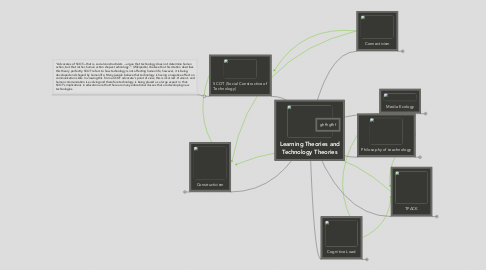Learning Theories and Technology Theories
por Kristen Howlett


1. SCOT (Social Constructive of Technology)
1.1. "Advocates of SCOT—that is, social constructivists -- argue that technology does not determine human action, but that rather, human action shapes technology. " (Wikipedia) I believe that his citation describes this theory perfectly. SCOT refers to how technology is not affecting human life, however, it is being developed and shaped by human life. Many people believe that technology is having a negative effect on communication skills. In viewing this from a SCOT advocate's point of view, this is incorrect. Human's and human communication is evolving and therefore technology is being placed as a large aspect in that. SCOT's implications in education are that there are many educational classes that are developing new technologies.
2. Constructivism
2.1. Constructivism is a theory that believes that learning is never finished. Education is based on building upon previous knowledge and experiences. Once a student gains opinions and perspectives from different individuals in their society, they then create their own. This is very similar to our education systems. Our grade school curriculum is based on this accumulation of knowledge. For example, in math classes we learn the basics and build upon that.
3. ghfhgfhf
4. Connectivism
4.1. Connectivism is a new learning theory for the "digital age". I believe that our classes and lesson plans should be directed towards connectivism. Nowadays children and adolescents use technology for more than personal and sparetime uses. There are so many resources that are accesible for them that create a fun learning environment that enables them to grow into responsible members of our society. As well, an important theory in connectivism is that students be able to not only be knowledgable with ideas but be able to find multiple ressources. Knowing where and how to find information is more beneficial than knowing facts. Connectivism also provides information is many forms, which is useful to our society that has a diverse range of learners. "Courses, email, communities, conversations, web search, email lists, reading blogs" (http://www.connectivism.ca/about.html) are many of the ressources our students will have access to. The digital world is envelopping our society and our students, students all have access to the internet and smartphones. They use them on a daily basis! Why, as educators, would we not take advantage of this? In my opinion, connectivism is the way of the future and the way our students have proven to learn best.
5. Media Ecology
5.1. First introduced by Neil Postman in 1968, media ecology refers to the concept that technology not only profoundly influences society, it also controls virtually all walks of life” (Wikipedia.) It studies how media and technology affects humans and their perspectives on everday life. As well, it views media environments and the roles of technology in society.
5.1.1. The implications of media ecology on education are that media and technology are now part of a daily routine at many schools. In using technology, students are constantly changing views and feelings upon many subjects. Technology is changing their perspectives on life.
